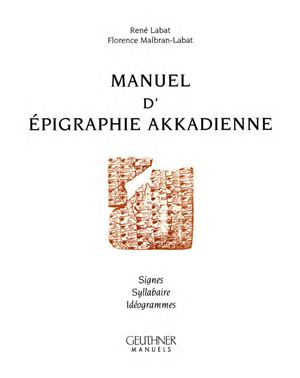Paris: Geuthner, 1995. - 379 p.
As its name suggests, Labat's Manuel d'epigraphie akkadienne ("Manual of Akkadian Epigraphy") is designed for readers of Akkadian, rather than other languages written in cuneiform script. Its advantages over Borger's Zeichenlexikon are that it presents all of its information on a sign in a single place, and that it systematically shows the evolution of sign-forms from the late fourth millennium onwards. This is a particularly attractive feature for leaers, as seeing the 'mature' forms of cuneiform signs together with their more pictographic precedessors helps to make them more meaningful. Equally useful are the little diagrams and symbols that show when and where particular values were used, and in which types of texts. On the other hand, Labat is not as exhaustive or as up-to-date as Borger.
The main features of Labat's Manuel are:
Introduction, on the history of cuneiform writing.
Indices of Neo-Assyrian and Neo-Babylonian signs.
Table of sign evolution (even pages).
Table of syllabic and logographic values, with periods, places and genres of attestation (odd pages).
Alphabetical list of sign values (including logographic values that are not in the main table).
Various useful tables of proper nouns (gods, cities, months, etc. ) and their logograms.
Index of Akkadian words and their logograms.
As its name suggests, Labat's Manuel d'epigraphie akkadienne ("Manual of Akkadian Epigraphy") is designed for readers of Akkadian, rather than other languages written in cuneiform script. Its advantages over Borger's Zeichenlexikon are that it presents all of its information on a sign in a single place, and that it systematically shows the evolution of sign-forms from the late fourth millennium onwards. This is a particularly attractive feature for leaers, as seeing the 'mature' forms of cuneiform signs together with their more pictographic precedessors helps to make them more meaningful. Equally useful are the little diagrams and symbols that show when and where particular values were used, and in which types of texts. On the other hand, Labat is not as exhaustive or as up-to-date as Borger.
The main features of Labat's Manuel are:
Introduction, on the history of cuneiform writing.
Indices of Neo-Assyrian and Neo-Babylonian signs.
Table of sign evolution (even pages).
Table of syllabic and logographic values, with periods, places and genres of attestation (odd pages).
Alphabetical list of sign values (including logographic values that are not in the main table).
Various useful tables of proper nouns (gods, cities, months, etc. ) and their logograms.
Index of Akkadian words and their logograms.

